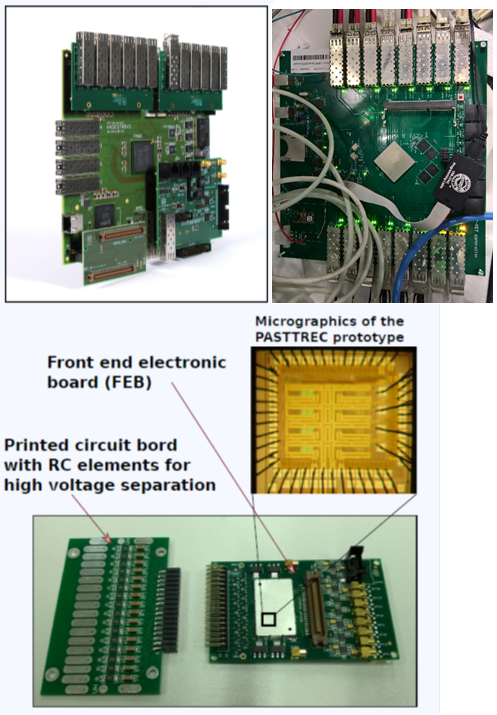Electronics Laboratory

The electronic laboratory deals with the development of dedicated electronics for ionizing radiation detector readout on both the small scale (for the needs of small experiments) and multi-channel systems typical for high energy physics experiments. From within the confines of the electronics development we cooperate with many leading research centers in Poland and from abroad that specialize in the development of high-integrated analog and digital electronics. The most important completed projects include:
- A readout system for an electromagnetic cascade gas detector of the HADES spectrometer (www-hades.gsi.de) comprising nearly 20,000 channels with analogue and digital tracks. The ASIC-type analogue chip was made in cooperation with AGH (the group of Prof. W. Dąbrowski), while the digital and cascades recognition systems with the University of Giessen (Prof. W. Kuehn) [Detailed description can be found in: A. Balanda et al. "Development of a Fast Readout System for HADES Shower Detector" Nucl. Instr. .Meth. A417 (1998) 360, The HADES Pre-Shower detector Nucl. Instr. Meth. A531 (2004) 445]
- A universal read-out board based on programmable FPGA chips with extensions for time measurement (TDC), amplitude (ADC) and data transmission in the GBEthernet standard, the Trigger and Read-out Board (TRB) made in cooperation with GSI Darmstadt (Dr. M. Traxler). The board is used in many large and medium
scale experiments and has a hierarchical architecture with a central trigger system. Its universality provides a number of measurement modes from multi-channel TDC
measurements, ADC measurements with an integrated data transmission system to data distribution systems and triggering control.
[For a detailed description, see: HADES and FAIR-experiments, IEEE Transactions of Nuclear Scienc e 55 (1) (2008) 59]
-
An electronics system to readout drift detectors developed for the PANDA experiment (www-panda.gsi.de) based on a configurable, analogue, type ASIC (PASTTREC) system developed in collaboration with AGH (Prof. M. Idzik) and on multi-channel TDC chips implemented in FPGA of the TRB boards.
[Publications: G. Korcyl et al. Readout Electronics and Data Acquisition for Gaseous Tracking Detectors, IEEE Trans.Nucl.Sci. 65 (2017) no.2, 821-827, D. Przyborowski Development of a dedicated front-end electronics for straw tube trackers in the bar PANDA experiment JINST 11 (2016) no.08, P08009] -
A tomographic data processing system based on a newly designed electronic board equipped with a hybrid Xilinx Zynq system (FPGA + ARM). The board allows for the
processing of up to 16 multi-gigabit data streams and generating a visualization of real-time tomographic data.
[Publications: G. Korcyl et al. Evaluation of Single-Chip, Real-Time. Tomographic Data Processing on FPGA - SoC Device IEEE Trans. Med. Imaging (2018)] -
A prototype of a data acquisition system for the PADA experiment (https://panda.gsi.de) consisting of front-end electronics, data concentrators, a SODANet subsystem synchronization system and of data processing infrastructure. All elements of the system are based on electronics equipped with FPGA's in which communication mechanisms and data processing algorithms, such as the reconstruction of tracks of particles passing through detectors are implemented.
The laboratory is richly equipped with evaluation boards with the latest FPGA systems, such as Xilinx Zynq MPSoC Ultrascale + or Virtex Ultrascale. This allows us to conduct a wide range of research on the use of FPGA technology for various applications such as acceleration of neural networks or Monte Carlo calculations.